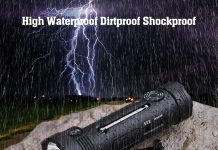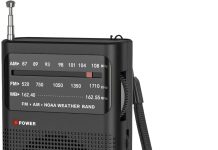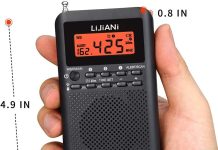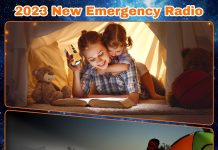Looking to ensure that you receive the best reception from your emergency radio? Well, look no further! In this article, we will provide you with expert tips and tricks to enhance the performance of your emergency radio, ensuring that you stay connected and informed during any unforeseen crisis. Whether you’re facing inclement weather or a power outage, our simple yet effective methods will help you optimize the reception of your emergency radio, leaving you feeling prepared and secure in any situation. So, let’s dive right in and discover how you can maximize the functionality of your emergency radio!
Review contents
Choose the Right Radio
When it comes to selecting an emergency radio, it’s important to consider its reception capabilities. After all, what good is a radio if it can’t pick up a clear signal? Look for radios that are known for their strong reception. Reading reviews and doing some research can help in identifying radios with excellent reception abilities.
In addition, it’s also worth considering a radio with multiple power sources. During an emergency, power outages are common, and having a radio that can operate on different power sources can be a lifesaver. Look for radios that can be powered by batteries, solar energy, hand-crank, or even electricity. Having versatile power options ensures that even if one source fails, there will be an alternative available.
Furthermore, radios with NOAA weather alerts should be a top consideration. These radios are equipped with the capability to receive weather alerts from NOAA (National Oceanic and Atmospheric Administration). This feature enables you to stay updated on weather conditions, severe storms, or any other emergencies in your area. Having a radio with NOAA weather alerts can provide you with crucial information to keep yourself and your loved ones safe.
Position Your Radio Properly
To maximize the reception capabilities of your emergency radio, it’s important to position it properly. Finding an optimal location can significantly improve the quality of the signal received. One recommended approach is to place the radio near a window or outdoors, as it allows for better reception due to the absence of obstructions. The best place would be a window or an area with open access to the sky.
When choosing a location, it’s essential to avoid obstructions that could interfere with the radio’s signal. Thick walls, dense furniture, or metal objects can hinder reception quality. Therefore, it’s best to place the radio in a location that minimizes such obstructions and provides a clear path for the radio waves to reach the device.
Extend the Antenna
Extending the antenna of your emergency radio is another vital step in improving reception. Most emergency radios come with a built-in antenna that can be extended. Make sure to fully extend the antenna for optimal reception quality. The extended antenna captures radio waves more effectively, resulting in a stronger and clearer signal.
If your emergency radio has the option to connect an external antenna, consider doing so. An external antenna can further enhance reception, especially in areas with weak signals or in rural settings. Position the external antenna vertically for better reception, as this orientation is known to provide the best results.
Adjust the Tuning
To fine-tune the reception on your emergency radio, it’s important to adjust the radio frequency. Sometimes, slight adjustments can make a significant difference in the clarity and strength of the signal received. Experiment with the tuning knob to find the optimal frequency for your desired station.
Scanning through different channels can also help identify the clearest signal available. Some channels may be crowded with interference, while others may have a clearer reception. By scanning through the available channels, you can find the one that provides the best reception for the station you want to listen to.
If your radio offers a manual tuning option, consider using it. Manual tuning allows you to precisely adjust the frequency to obtain the best reception. This can be particularly helpful if you are trying to receive a weak signal or tune in to a specific station.
Power Sources and Batteries
Having a reliable power source for your emergency radio is crucial. Ensure that your radio has fresh batteries, as weak batteries can affect reception quality. Check the battery levels regularly and replace them as needed, especially during extended power outages or emergencies.
Consider using rechargeable batteries and a solar charger in conjunction with your emergency radio. Rechargeable batteries can be an eco-friendly and cost-effective option, as they can be used repeatedly. A solar charger allows you to replenish the battery power of your radio using sunlight, providing a sustainable and renewable energy source.
Furthermore, having a backup power source is always a good idea. Many emergency radios come with a hand-crank feature, allowing you to manually generate power by turning a crank. This feature is especially useful during prolonged power outages when batteries may become depleted. By cranking the radio, you can power it up and ensure that you have access to important information.
Reduce Interference
Minimizing interference is essential in maximizing reception quality. Electronic devices and appliances can emit electromagnetic signals that interfere with the radio’s reception. To mitigate interference, keep electronic devices and appliances away from the radio as much as possible.
It is also advisable to avoid using cell phones or Wi-Fi routers near the emergency radio. These devices emit electromagnetic waves that can disrupt the radio signal. Keeping them at a distance will help ensure a clearer and uninterrupted reception.
Another effective way to minimize interference is to switch off nearby electronic devices when listening to the radio. This includes items like televisions, computers, or other radios. By reducing the number of electromagnetic signals in the vicinity, you can improve the radio’s reception and enjoy a clearer and more reliable signal.
Use an External Speaker
Sometimes, the audio quality of an emergency radio may not be sufficient, especially in noisy environments or areas with weak speakers. Connecting the radio to an external speaker can greatly enhance the audio experience. Look for a speaker that is compatible with your radio’s audio output.
Position the external speaker strategically to optimize sound projection. Placing it in a central location or near the area where you will be listening to the radio can improve audio clarity. Experiment with the speaker placement to find the position that produces the best sound quality.
By utilizing an external speaker, you can enjoy a clearer and more immersive audio experience, ensuring that you do not miss any critical information during an emergency.
Stay Updated with Local Information
During emergencies, staying updated with local information is crucial for your safety and well-being. To ensure you receive the latest information, tune in to local emergency broadcast stations. These stations often provide real-time updates, including weather alerts, evacuation instructions, or any other relevant information.
In addition to radio stations, following official social media accounts is another reliable way to stay informed. Government agencies, local authorities, and other organizations often utilize social media platforms to disseminate important information during emergencies. By following these accounts, you can receive updates directly on your feed, keeping you well-informed and prepared.
While listening to emergency broadcasts, pay attention to specific instructions from authorities. Such instructions are vital for your safety, and following them will help you navigate through the emergency situation effectively.
Regularly Test Your Radio
To ensure that your emergency radio is functioning properly when you need it the most, it’s important to perform routine checks. Test the radio’s reception in different locations around your home to verify its performance. This will help you identify any potential dead spots or areas with weak reception.
Additionally, test the radio’s reception during different times of the day. Radio waves can behave differently depending on atmospheric conditions, time of day, or even nearby structures. Testing the radio’s reception in various scenarios will give you a better understanding of its capabilities in different situations.
If you encounter any reception issues or suspect a fault with the radio, promptly replace or repair any faulty components. It’s better to address any problems or malfunctions in advance, ensuring that your emergency radio is always in optimal working condition.
Keep Your Radio Well-Maintained
Regular maintenance is essential to keep your emergency radio in top condition. Clean the radio regularly, making sure to remove any dust or debris that may accumulate over time. Dust build-up can affect the radio’s internal components, potentially impacting its performance.
When not in use, store your emergency radio in a dry and secure location. Moisture can damage the internal circuitry of the radio, leading to malfunctioning or complete failure. Keeping the radio in a safe and dry place prolongs its lifespan and ensures that it is always ready for use during emergencies.
Lastly, follow the manufacturer’s instructions for maintenance. Every emergency radio is unique, and manufacturers often provide specific guidelines on how to keep their product in optimal condition. Following these instructions will help preserve the radio’s performance and ensure its reliability when you need it most.
In conclusion, optimizing the reception of your emergency radio is essential for staying informed and prepared during emergencies. By choosing the right radio, positioning it properly, extending the antenna, adjusting the tuning, and using the appropriate power sources, you can enhance reception quality. Reducing interference, using an external speaker, staying updated with local information, regularly testing the radio, and keeping it well-maintained are additional steps that contribute to a reliable and efficient emergency radio. By applying these tips, you can ensure that your emergency radio performs at its best when it matters most – during times of crisis.



























